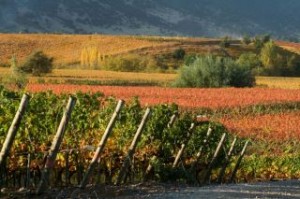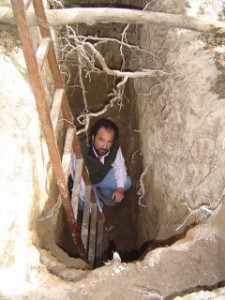Casa Silva research Chilean terroir
The Colchagua valley in Chile is developing an increasing reputation for producing high quality red wines, from grape varieties such as cabernet sauvignon, carmenère and syrah. And it is in this valley that Viña Casa Silva, a carmenère specialist, have spent three years researching the small scale growing conditions – which they call micro-terroir – of carmenère and other grape varieties, in their Los Lingues (Andean foothills) and Lolol (Pacific coastal) vineyards, both in Colchagua valley.

Los Lingues vineyard
The Casa Silva study came about because the family-owned and run company wanted to understand why they had the same grape variety in the same climate but they were getting quite different wines. They wanted to explain this variability so the knowledge could be used to grow grapes better matched to the style and quality of wines they wanted to make.
And they’ve discovered that even very small distances in the vineyard can produce different results in the wine, which is making them re-evaluate what they plant and how they manage the vineyard on a micro-scale.
How it happened
The research project was started in 2005, by Casa Silva’s technical director and chief winemaker Mario Geisse, in conjunction with Professor Yerko Moreno of the University of Talca, where he is the director of grape and wine research, specialising in viticultural issues including clonal selection.
They started looking at small ‘terroir units’ of 0.1 to 0.5 hectare with an aim to identify the pre-requisites for growing high quality carmenère in Colchagua.
They investigated crop load (the weight of grapes per vine), vegetative vigour (foliage), as well as the soils, which have all been brought down from the Andes over the last 300,000 years, and contain more or less rock, depending on location. Professor Moreno said the team identified “small terroir units for carmenère, cabernet sauvignon, viognier, syrah, petit verdot, considering climatic conditions, topography, soil composition and origin, vine rootstock, variety and clone, and viticultural managment.” He said they dug hundreds of soil profiles, describing them for chemical composition, water holding capacity, rooting capacity, which allowed them to separate areas into different units, broadly along the lines of sand, limestone and clay.
They measured growth parameters of the vine, including the vegetative canopy and yield, and related this to bunch shade/exposure. Moreno said: “If you have a grape cluster that is too exposed under our conditions, you can cook the berries. It’s completely different from areas of cooler climate. It can reach up to 45°C in our valley.” What they found was that sunny berries had lower colour, harder and drier tannins.
Then they did lots of small batch winemaking and carefully analysed the resulting wines, creating a virtual warehouse of vineyard and winery data. Once they started to sort out some of the effects, Moreno said “One of the most important for me was the water behaviour of plants. Cultivars have different responses to stress – syrah copes with more stress than cabernet sauvignon. And vines of the same cultivar behave differently in different sites, and within one season.” He added “cabernet sauvignon with severe water stress produced more astringency in the wines, the tannins were too harsh. And if there was no water stress, we tended to have similar problem – the tannins were too harsh.”
But on carmenère the results were different. With no water stress there were “green characters. We got some dry tannins with increased water stress, though not as much as cabernet sauvignon.” He explained “the best expression of carmenère was achieved where the plant had to explore greater soil volume to get its water supply, at least one metre deep.”
The results of this research are enabling Casa Silva to replant areas of vines. Moreno said: “I would change the way the vineyards are planting, not the direction of rows. This project is aiming to produce high quality wines, the variabilities are subtle. New plantings are being done considering the soil.” Combine this with tweaking vineyard management to realise more potential from their grapes should enable Casa Silva, Geisse said, “to get the best possible quality wines” from each plot.
The research also revealed quite marked genetic variability in the carmenère vines, so Casa Silva recently embarked on new research into carmenère clones to identify those that produce better quality fruit for high class winemaking.




